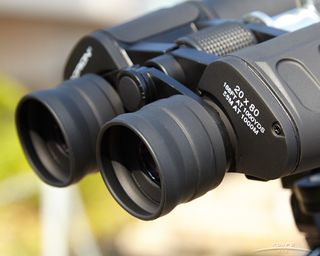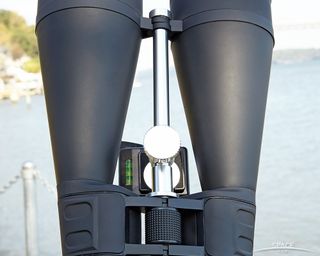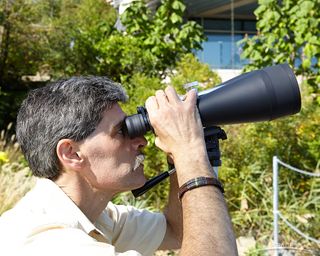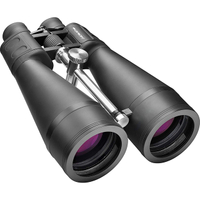Orion 20x80 Astronomy Binoculars: Full Review

I think of the Orion Astronomy 20x80 binoculars as the perfect "gateway gear" to heavyweight stereoscopic skywatching. They offer a whole lot of binocular for the buck, with big aperture and big-league specs. Plus, they have the quickness of a center focus knob. However, you'll have to make some sacrifices to save money; this set costs about $120.
These 20x80s are a less-costly, lighter-weight and only slightly less-powerful alternative to our Editors' Choice Celestron 25x100. One way to think of it: The Orions give you at least 85 percent of the experience, at half the price of the Celestrons. And, in some ways, the Orions are nicer to handle.
Below: Hands On Video Tour of Orion's Astronomy 20x80s:
The Orion 20x80s and the Celestron 25x100s are very similar in shape and are almost identical in packaging. It's hard to believe they don't come from the same factory in China (as, in fact, do several other brands' binoculars).
Almost exactly like the slightly larger Celestrons, the big Orions come swaddled in a four-sided articulating wrap of nylon-clad thin fiberboard. This rig has an elastic bellyband and a nonstretchy strap with a hook and loop ("Velcro") closure. Thus sheathed, this rig slips into a plastic leatherette shoulder bag. It's not perfect but acceptable at this price point.
Related: See our Buyer's Guide: How to Choose Binoculars for Stargazing
The Orions' lenses (and, therefore, aperture) are not quite as big the Celestrons,' nor are the prisms quite as safely shock-mounted. But the 20x80s are nicely multicoated. They seem to stretch contrast (bright to dark ratio) a bit, making it fun to soak your brain in the faint starlight of diffuse open clusters or groups of galaxies. Most planetary nebulas are too far away to really see much detail at 20x magnification. But you can get a whimsical sense of what the neighboring suns might think of them.
Get the Space.com Newsletter
Breaking space news, the latest updates on rocket launches, skywatching events and more!

Fold-down rubber eye guards let us eyeglass wearers get tack-sharp stars at infinity focus. With 17 millimeters (0.7 inches) of eye relief, you may not find the fold-down necessary. The rubber felt very stiff to me, causing me to question whether it might rip in cold conditions. But I haven't found any reports of this.
Best Astronomy Binoculars (Editors' Choice)
Like others in this class, the Orion Astronomy 20x80s are really a pair of short-tube refracting telescopes, aligned for one set of human eyes to enjoy. But unlike most other large binoculars, these have a center focus wheel. That's both a curse and a blessing. Center focus is faster and easier. But if your main interest is astronomy, your focus won't change much. (The planets, stars — and even the moon — are all at "infinity," as far as Earth-bound binoculars are concerned.) The focus achieved with individual independent eyepieces (as on the Celestrons) can be more precise and less likely to slip. The Orions I tested had a mushy, dead spot at their end counterclockwise ("left") rotation of the focus knob, but it didn't adversely affect the focus.
Most of the goodness of two-tube astronomy comes from what happens when your brain is painted with two channels of visual information. Just as listening to music in stereo gives you more than just a spatial impression of the audio, binocular astronomy makes you feel immersed in the celestial object and the sky around it. This psycho-perceptive effect stems from what your mind does with two slightly varying data sets. It can infer information about mass, and even allude to an object's likely motion. Your "mental image" of, say, a comet may not be entirely correct. (You may think you see depth or volume of the object that isn't really there.) But it is certainly a more emotionally satisfying experience than peering at the universe with one eye.

Reminiscent of the Celestron 25x100 binoculars, these Orions sport a round, metal bar spanning the long dimension from just "aft" of the 80-mm (3.1 inches) objectives running back to the area of the central focus knob. Sliding along this, a cylindrical mounting shaft with built-in tripod adapter can be clamped at any desired point by torquing down the knob. (The long spine gives you a lifting point to hoist the binoculars on and off your tripod.)
One huge plus in Orion's favor is that the rubber objective lens caps have a deep flange that plunges into the rubber-coated brow sockets around the lenses. It is one of the most secure lens cover systems we've seen, and very unlikely to fall out and roll away to the dark of night. Few other binoculars' lens covers gave us this much confidence. This rubber-rubber interface will keep out moisture. But it can also lock it in, if you store your binoculars before letting them get thoroughly dry. That's a real no-no.
Every Orion telescope or binocular set comes with superb, clearly written documentation. This one is no different. It's a single sheet (two sides) describing how to set up and use the 20x80s, along with their smaller siblings in the line 20x70s and 15x70s. Even if you know nothing about binocular astronomy, this literature will get you up and running and enjoying the sky. It will, of course, also tell you how to care for your Orions. There's a particularly good section of how to avoid fog — and mold — in your 20x80s' superior optics.
Orion publishes a warning with these binoculars (and many of its products): "Please note this product was not designed or intended by the manufacturer for use by a child 12 years of age or younger." This may reflect the company's very appropriate concern that you should never look at the sun, especially with any kind of magnifying device, unless it is properly filtered. Or, it may be about the product liability of a heavy object hoisted around in the dark. Or the breakability of its big glass lenses. Whatever it was, we didn't see similar legal language from other brands.
Specifications
- 20x Magnification: Objects appear about 30 times larger than your eye alone would see them.
- 80-mm (3.1 inches) Objective Diameter: The large lenses on the front measure 80 millimeters across
- 4.75-lb. (2.15 kilograms) Weight: At 4.75 lbs., these binoculars weigh about half our Editors' Choice — a great "lite" alternative.
- 3.2-degree Field of View: Big astronomy binoculars won't be very wide, but objects in the sky don't move (much).
- 168-foot (51 meters) Aspect Width at 1,000 yards (914 m): Another way to visualize field of view: Wider might be better for close, long-tail comets.
- 4-mm (0.16 inches) Exit Pupil: Bigger is better — ideally, larger than the diameter of your dark-adapted eye's pupil (varies with age).
- $120 Street Price: At $120 (plus shipping), these Orions offer an economical way to get into the heavyweight class.
Orion calls this line "Astronomy," and these binoculars excel at viewing the night sky. But you can, of course, use them in daylight for terrestrial pursuits like sports and busybody neighbor-viewing (though we don't advocate this practice). But they're not so great for birding, unless you're watching an active nest. They won't focus closer than 60 feet (18 m), and they will need to be tripod-mounted for any observing lasting longer than about 20 seconds.

Frankly, some people find large binoculars too much of a hassle. I suggest that you go to a star party and try them for yourself. Most amateur astronomers are only too happy to let you fly their telescope or binocular "starships" for a few minutes. Feel free to ask them questions. If you find you like the jumbo-size stereo sky experience, the Orion Astronomy 20x80s paired with a matching Orion swing arm mount and tripod would be an excellent next step into the hobby. Soon, the binocular expert at the star party could be you!
<a href="https://target.georiot.com/Proxy.ashx?tsid=72128&GR_URL=https%3A%2F%2Famazon.com%2FOrion-51464-20x80-Astronomy-Binoculars%2Fdp%2FB00D12U1H6%3Ftag%3Dhawk-future-20%26ascsubtag%3Dhawk-custom-tracking-20" data-link-merchant="Amazon US"" rel="nofollow" target="_blank">Buy Orion 20x80 Astronomy Binoculars on Amazon.com
- High magnification & large aperture
- Tripod adapter included
- Price: $130
To check out some other binoculars, or to learn how to evaluate and compare binoculars, please try these links:
- Best Best Binoculars for Astronomy, Nature, Sports and Travel
- How to Choose Binoculars for Astronomy and Skywatching
- Celestron SkyMaster 25x100 Binoculars Review
- Celestron SkyMaster 8x56 Binoculars Review
Follow the author @DavidSkyBrody. Follow us on Twitter @Spacedotcom and on Facebook.

Join our Space Forums to keep talking space on the latest missions, night sky and more! And if you have a news tip, correction or comment, let us know at: community@space.com.
Dave Brody has been a writer and Executive Producer at SPACE.com since January 2000. He created and hosted space science video for Starry Night astronomy software, Orion Telescopes and SPACE.com TV. A career space documentarian and journalist, Brody was the Supervising Producer of the long running Inside Space news magazine television program on SYFY. Follow Dave on Twitter @DavidSkyBrody.


